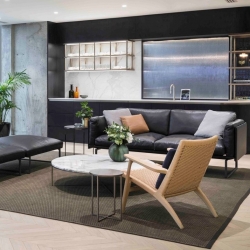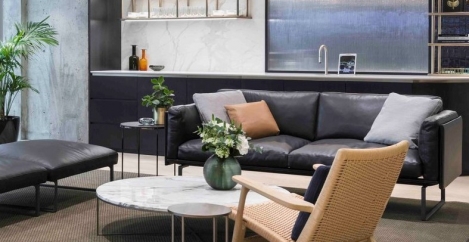January 27, 2021
The lessons learned under the pandemic that will apply after it all ends
 Recently lighting control firm Prolojik assembled an expert panel to talk about learning and working during the time of the Covid-19 pandemic. The roundtable (online of course) involved participants from various fields related to the built environment including those involved in developing, designing and tech reflected on their own experiences over the last several months. While industry issues raised during the session included what productivity really means and how to measure it, what infrastructure needs to be in place to enable people to return to their place of work or education and why a joined-up approach to wellness is an indisputably necessary strand of building management.
Recently lighting control firm Prolojik assembled an expert panel to talk about learning and working during the time of the Covid-19 pandemic. The roundtable (online of course) involved participants from various fields related to the built environment including those involved in developing, designing and tech reflected on their own experiences over the last several months. While industry issues raised during the session included what productivity really means and how to measure it, what infrastructure needs to be in place to enable people to return to their place of work or education and why a joined-up approach to wellness is an indisputably necessary strand of building management.
Education and employment represent the two most important life phases for most people in developed countries. Both bringing people to learn and work together, both critical parts of any functioning society with an unparalleled impact on the way we live and, pertinent for those involved in the built environment industry, two of the largest occupiers of space.
During the recent lockdowns and tier restrictions these two pillars either remained open or were some of the last institutions that were forced to close and revert to virtual versions. Reflecting on being a supplier for those learning and working under a pandemic, Asela Rodrigo, founder and managing director of Prolojik reflects on the year saying, “From about May onwards, the focus was not just about this pandemic but using this experience to get a better outcome in the event of something similar happening again for our clients in education and workplace, using the capabilities of everything from the WELL building standard to air quality standards and understanding the usage of spaces. For example, how many students are in each classroom, what the footfall demands are,” he says, adding that it is essential to build technologies that give people confidence to use and reengage with spaces.
[perfectpullquote align=”right” bordertop=”false” cite=”” link=”” color=”” class=”” size=””]We’re thinking about what if you had an ability to see the quality of the space you’re walking into, in real time[/perfectpullquote]
“We’re thinking about what if you had an ability to see the quality of the space you’re walking into, in real time, whether that’s a commercial space, retail outlet or leisure facility.” He says that people don’t just want to think about what’s happened in the last nine months, “It’s about learning from that and taking us forward into the rest of 2021.”
Neil Pennell, head of Design Innovation and Property Solutions with Landsec echoes this: “The built environment has a key part to play in creating good, safe, secure spaces for people to be in. History has shown us that buildings and the services they provide are inextricably linked with the well being of their users. In the past it was the introduction of of clean water and sanitation to prevent the spread of cholera and typhoid and good daylight and fresh air to reduce disease transmission, things we now take for granted. We need to use the experience gained from the intelligent use of space, new materials and smart technology in combating the pandemic to help us to avoid and react to emerging disease outbreaks more effectively in the future.”
He says that building users are going to be more demanding post pandemic, seeking reassurances that proper care and attention has been paid to provide the best possible environment for them to enjoy. “We are social beings, when humans come together in the workplace it’s about the shared experience where people can do what they do best; educate, nurture, inspire, engage and create. We need to ensure that our buildings support these activities in the most secure way possible. They need to be resilient and flexible in the face of the future challenges. I am sure that the lessons learned from the pandemic will cause us all to rethink and reconsider how we deploy the spaces that we already have and reimagine the design of new buildings. Going forward health and well being will be a core attribute of the built environment.”
Changing benefits
Alan Rowell, director with Qoda Consulting, gives his perspective on this year’s events and the effects of the pandemic. “Everybody was very enthusiastic and saw a lot of benefits and the first two or three months was very productive because you were able to push some more distracting activities from the working day to one side. Then as you go through the next couple of months, I noticed there was a dip in productivity, where people actually found it quite hard to work from home. And people started to miss social interaction, which had been seen as one of those kind of extracurricular activities, but is actually core to people’s work and productivity. And then I’ve watched people’s enthusiasm level go up and down. I’ve witnessed lots of debates about the future of the office. And I think where we are at the moment is people now value the office for many reasons. Everybody realises the difference of working from home, or as I’ve heard it termed recently ‘living at work’, and you need a kind of segregation in your life.”
[perfectpullquote align=”right” bordertop=”false” cite=”” link=”” color=”” class=”” size=””]What COVID-19 has done is propelled everything to the boardroom table with conversations that are more meaningful around sustainability and around wellness[/perfectpullquote]
Yorgo Lykouria, founder and creative director with design studio Rainlight says, “The learning aspect of being in a workplace is very important. And I think the ones who are suffering the most right now are the younger people in the workplace, who are losing out on the benefit of mentorship. Normally, they would have [face-to-face interactions with] someone older, who’s got more experience and potentially wisdom, but also they would be picking up the background chatter and of course learning in a very human way by watching. Also, when we talk about productivity, you could come up with an idea in minutes that can make millions or you could spend months and achieve nothing. So the idea of productivity is a little bit of a myth; that spark of genius that can happen in a moment has more value,”
Nicola Osborn, creative director with Basha Franklin shares her experience, “We were actually very busy going into lockdown, we had two live projects in the highly collaborative stages. We realised very quickly the amount of time required and the intensity of carrying out collaboration virtually. It is so tiring, you have to communicate in a very different way on a virtual platform. We adapted but missed being in the same space together and problem solving.”
In terms of the impact on the way design of interiors has been viewed she adds, “I think what COVID-19 has done is really propelled everything to the boardroom table with conversations that are more meaningful around sustainability and around people’s wellness, because for a long time, it has been more of a tick box exercise rather than a purposeful investment to make a difference. Everyone, including the client, can contribute to making beautiful and joyful buildings that makes us happy.”
Mark Eltringham, Editor of Workplace Insight and IN magazine says it’s not a binary choice about working from home or the office, “Over the last few months there was the realisation that actually we don’t have to make these simplistic choices. We’ve got more into talking about wellbeing and collaboration and the value of work and people. He does however strike a note of caution, “People are clinging onto the idea of if your job can be done from anywhere, then it will be done from anywhere. But then their employer might say ‘actually we can contract this out’ and people have got to face up to this potential threat to their livelihoods.”
As Yorgo Lykouria adds finally, “This is a chance for kind of revolution, isn’t it. It’s an exciting time for the property world, because really is about coming up with new ideas.”
Participants:
Yorgo Lykouria – Founder and Creative Director of Rainlight
Nicola Osborne – Creative Director, Basha-Franklin
Alan Rowell – Director, Qoda Consulting
Neil Pennell – Head of Design Innovation and Property Solutions
Asela Rodrigo – Managing Director of Prolojik
Mark Eltringham – Publisher of Workplace Insight and IN magazine














